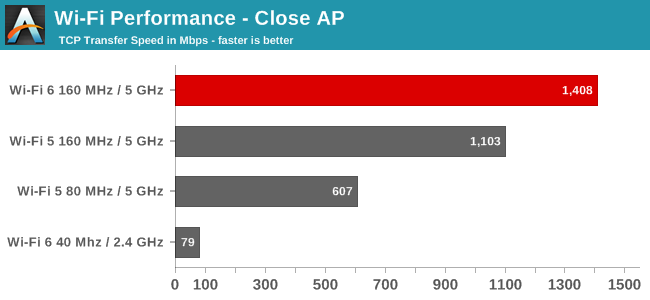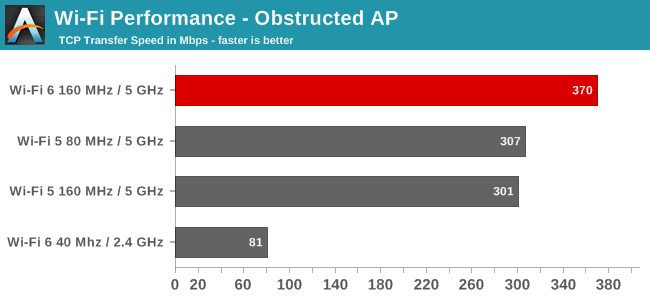AT 101: Wi-Fi 6 And Why You Want It
by Brett Howse on February 12, 2020 8:00 AM ESTPerformance
In order to achieve maximum performance, the latest Wi-Fi 6 standard leverages 1024-level QAM, but depending on the signal strength and quality it will scale down as needed, so to achieve the best performance very high signal to noise ratios are going to be required. Since 5 GHz is attenuated dramatically when it has to go through walls, if you need maximum Wi-Fi performance be aware that you are going to want your wireless router as close to the end device as possible. Luckily that is not an issue in our case, since the router is in the same room when testing for maximum performance, but we’ll also evaluate it in less than ideal scenarios as well.
Wi-Fi 5 vs Wi-Fi 6 – Close AP
First up we’ll test the TCP performance when the Access Point is in the same room as the client.

The performance advantages of Wi-Fi 6 are clear. With the access point in the same room, the SNR is very good and the new 802.11ax standard can really shine. With 1024 QAM and 160 MHz channels, the performance is over twice as fast as the outgoing Wi-Fi 5 with 256 QAM and 80 MHz channels. It is very impressive to see a typical 2x2:2 connection well over the Gigabit barrier, and even though the AX200 network card is the first generation, Intel has already done a fantastic job tuning it. The theoretical maximum transfer rate with 160 MHz channels and 1024 QAM is around 1200 Mbps per connection, so a 2x2 can in theory hit around 2.4 Gbps, meaning there's still room for improvement. Since 802.11ax also can be used on the 2.4 GHz frequency, unlike 802.11ac, the same test was also done on 2.4 GHz, and the results were disappointing. 2.4 GHz can still offer 40 MHz channels, but it doesn’t seem like the AX200 could take advantage of any of that. For reference, the wireless adapter in the laptop was reporting -21 dBm, which is a strong signal, which makes sense since the AP is almost right next to the laptop.
Wi-Fi 5 vs Wi-Fi 6 – Reduced Signal
Moving the laptop further away, and adding several walls and doors in the way to attenuate the signal, the same scenarios were again tested.

With some walls in the way, 5 GHz gets attenuated quite dramatically, and the SNR in the second location was -78 dBm. With such a low signal, the Wi-Fi 6 connection wasn’t able to take advantage of the 1024-level QAM and would have had to drop down to a much lower set, reducing the number of bits per tone, and even though the total channel bandwidth was still 160 MHz, it was only marginally faster on 802.11ax than 802.11ac 80 MHz. 2.4 GHz is not as impacted by walls, and as such was able to maintain the same transfer rate, even though it was still quite a bit slower.
So the results are clear. Wi-Fi 6 can offer a significantly higher level of throughput than Wi-Fi 5, but in order to do so, it needs a strong signal. The Wi-Fi 6 still outperformed the Wi-Fi 5 in the second test with an attenuated signal, but the performance gain was minimal. 2.4 GHz still offers the best signal strength, and therefore would be able to connect further away, and through more obstacles, but doesn’t offer anywhere near the performance of the 5 GHz range. It will be interesting to see the Wi-Fi 6E devices with 6 GHz support when they launch. It will open up Wi-Fi to a wider set of frequency choices, but will offer even less range.










149 Comments
View All Comments
Samus - Friday, February 14, 2020 - link
Well sure, I have clients downtown with Gigabit fiber from Cogent, who offers speeds up to 10Gbps, but that isn't residential. The install alone is $5000 and it only covers the 'loop' (downtown business district.)I live 15 miles outside of the loop, technically in a Chicago suburb (Evergreen Park) and get AT&T Fiber, run inside my house from the pole, to a media converter that converts it to Ethernet.
I've read some peoples installs only use one strand of fiber (so half duplex) but report identical speeds with just slightly higher latency (around 10ms) so it really depends on the ISP's implementation.
But again, I doubt there is anywhere in the US you could find an ISP offering 'residential' internet service at beyond gigabit speed. And the router in question here is a consumer router with a gigabit uplink, so I think that's probably fine...for now :)
Mvs321 - Thursday, February 13, 2020 - link
I live in Denmark, I pay around 36 dollars per month for a 1GB connection, to me it seems pretty cheap, but what do you pay?asfletch - Thursday, February 13, 2020 - link
In Australia, I pay more than that for a rubbish 50mbs connection. Not even joking. About US$50. Our federal Govt is so full of flat-earthers it nixed FTTH as being a threat to existing news and cable companies. Sigh.PeachNCream - Thursday, February 13, 2020 - link
My ex lives in Canada. Bell offers a max of 1.5mbit and a there is a 20GB per month cap. This is just south of Ottawa so I don't think your experiences can be fairly applied to the entire nation.29a - Thursday, February 13, 2020 - link
I'm in the US and I used to get 12Mb from Frontier but the phone line got knocked down so Frontier just tied it to a tree instead of replacing the pole and now I get 9Mb. (true story)bcronce - Wednesday, February 12, 2020 - link
Because ping spikes? Because of larger buffers, TCP windows tend to size themselves to your link rate and not your sustained provisioned rate. If your wifi device is consuming 3Gb/s for 30ms to upload that picture you just took, packing it up and sending to the AP. Then you AP attempts to send that data at 1Gb/s, now you have a 100ms ping spike, even if your average rate is 83Mb/s for one second.I can generate ping spikes and packetloss on a 1Gb/s connection streaming videos with an "average" of 30Mb/s. Micro-bursts. I've fixed this at my home by smoothing out the bursts with traffic shaping. You drop and delay a few strategic packets to prevent a massive burst of loss and latency.
Makaveli - Wednesday, February 12, 2020 - link
ping spikes are a huge issues on Cable internet because of its asynchronous nature of it. Saturate that 30mbps upload bandwidth on that 1Gbps connection and everything gets affected. You need room just for the ACK packets. And glad I don't to deal with that anymore.Billy Tallis - Wednesday, February 12, 2020 - link
I think you mean asymmetric, not asynchronous. But yeah, anything beyond about a 20:1 ratio is basically false advertising on the downstream speed.Makaveli - Wednesday, February 12, 2020 - link
Yes you are correct I noticed it after but no edit in comments :(bcronce - Wednesday, February 12, 2020 - link
The small town ISP here only sells dedicated symmetrical FTTH connections. They have enough trunk and peering bandwidth to allow microbursts. I've seen 1Gb microbursts all the way from YouTube Europe and I'm in the middle of the USA.Actually, higher RTT routes tends to have higher bursting. Current TCP implementations are only paced by ACKs. If the TCP connection is idle and data is to be sent, the sender will send an entire TCP window worth of data instantly at full line rate. You can feel it when a 100Gb/s youtube server attempts to send you a 250KiB chunk of a video stream.